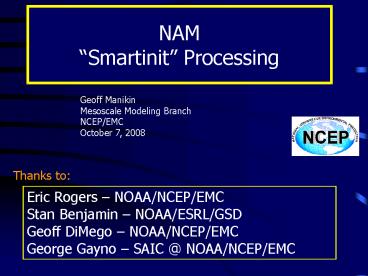NAM Smartinit Processing PowerPoint PPT Presentation
1 / 29
Title: NAM Smartinit Processing
1
NAM Smartinit Processing
Geoff Manikin Mesoscale Modeling
Branch NCEP/EMC October 7, 2008
Thanks to
Eric Rogers NOAA/NCEP/EMC Stan Benjamin
NOAA/ESRL/GSD Geoff DiMego NOAA/NCEP/EMC George
Gayno SAIC _at_ NOAA/NCEP/EMC
2
The NDFD consists of gridded forecasts of
sensible weather elements
Currently available for CONUS (5km), Alaska (6
km), Hawaii (2.5), Puerto Rico (2.5), and Guam
(2.5)
80 km
first guess created by local NWS offices using
smartinit processing which is run on
lower-resolution NAM or GFS grids
temperatures, dew points, winds are downscaled
to fit hi-resolution terrain
3
This smartinit processing for the NAM is now
being run at NCEP advantages
Save resources at local offices
Use higher resolution NAM data 12 km vs. 40
Native levels vs. isobaric
Improved PoP product using SREF
Provide first guess for RTMA AK,HI,PR (no RUC)
4
METHODOLOGY
Run for NAM output every forecast hour out to 84
hr for 00/06/12/18z cycles full processing
every 3rd hour
Use 12 km native grids
Perform basic interpolation to 5 km NDFD grid
Employ downscaling method used in RUC with 5km
terrain field to adjust T, Td, u, v
Use SREF to assist with PoP
5
Downscaling Technique - Vertical
Temperature
If Znam gt Z5km use local lapse rate in lowest
25 km, constrained between dry adiabatic and
isothermal to extrapolate down to 5 km terrain
If Znam lt Z5km Interpolate from native NAM
levels, but constrain downscaled sfc T not to
exceed sfc T from NAM (critical for representing
late night inversions)
6
Downscaling Technique - Vertical
Dew Point
If Znam gt Z5km maintain initial dew point
depression, using New downscaled temperature
If Znam lt Z5km Recompute Td using new sfc
pressure and NAM water vapor mixing ratio at
level 1 (vertical interpolation doesnt work well
when drier air is located just above a strong
inversion
7
Downscaling Technique - Vertical
u/v winds
If Znam gt Z5km use 1st level model winds
If Znam lt Z5km Interpolate from native NAM
levels, and then multiply by 0.7 to crudely
mimic friction Use maximum of that wind or 1st
level wind
8
Downscaling Technique - Horizontal
Use 5 km vegetation type data set for CONUS and 5
km land mask for AK, PR, HI to sharpen T, Td, u,
v along coastlines
Compare veg type (land mask) at each DNG
point for 5 km data and field interpolated from
12 km)
If they differ, set DNG values from nearest
NAM-12 point with the same mask but only if
contiguous bodies of water are present in both
data sets Look for continuity by recursively
expanding frames around points with different
mask values
9
(No Transcript)
10
(No Transcript)
11
(No Transcript)
12
(No Transcript)
13
(No Transcript)
14
(No Transcript)
15
PoP
- Original smartinit PoP completely tied to model
QPF - higher QPF higher PoP, especially if model RH
is high - Probably worked reasonably well in old days of
Eta model the model tended to spread convective
precip over large area and only predicted
significant amounts when there was good reason to
do so
16
The Problem
- At high resolution, the NAM generates intense
bullseye convective maximums of QPF that often
dont verify precisely
- Smatinit PoP computation would give 90 PoP
values at locations with the heaviest precip with
0 PoP values surrounding them
17
Example of Old Methodology
Method gives Pop values only where model QPF
exists
18
New PoP Method
- NAM PoP is not completely discarded in order to
maintain some continuity with the model QPF field - Computes PoP from old method using NAM QPF, but
it brings in probabilities from SREF for a
blended final product - Wont be an issue for NAEFS or any ensemble
system which already generates PoP values!
19
(No Transcript)
20
18z obs
21
SNOW
- Predicts inches of snow in 3 and 6-hr periods
- Uses snow water equivalent from model
- Takes average predicted downscaled sfc
temperature during period of interest and
generates a ratio based on that T - Uses 81 at 0 C, 71 at 2 C, 201 at -9 C
22
(No Transcript)
23
(No Transcript)
24
(No Transcript)
25
(No Transcript)
26
(No Transcript)
27
Future Plans for Smartinit
- Need to add weather string
- - code actually generates text like Likely
Showers Slight Chance Thunder but tough to put
into grib format - Add max/min tracker to be able to use in between
hour data for max/min - Bias correction?
28
Can smartinit be adapted for NAEFS?
Quick response YES!
Run bias correction on any ensemble system grid
and then interpolate to hi-res NDFD grid
Run smartinit processing to generate NDFD
variables
Max/Min fields may be tricky due to limited
output times
29
FIELDS NEEDED FOR SMARTINIT
- Sfc pressure, height, and visibility
- Vertical profiles of T, u, v, q, cloud fraction
- Precipitation and PoP 3, 6, and 12-hr accums
- Precipitation type
- 3 and 6-hr model snowfall
- 10-m wind and wind gust
- 2-m T, q, dew point
- Lifted index and wet bulb zero height
- Vegetation fraction
- T _at_ 950, 850, 700, 500 mb RH _at_ 850, 700
- Hi-res terrain and land mask datasets

